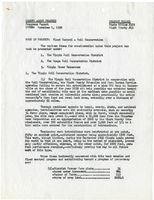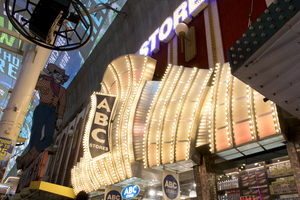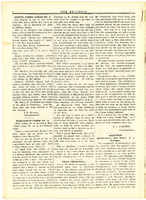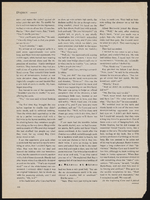Search the Special Collections and Archives Portal
Search Results

Hernando Amaya oral history interview: transcript
Date
Archival Collection
Description
Oral history interview with Hernando Amaya conducted by Laurents Banuelos-Benitez, Marcela Rodriguez-Campo, and Barbara Tabach on October 18, 2018 and December 3, 2018 for the Latinx Voices of Southern Nevada Oral History Project. In this interview, Hernando Amaya talks about his childhood and education in Bogota, Colombia. He discusses his start in journalism as a young man and working for El Espectador, the Colombian national newspaper. He discusses his experiences reporting on the narco-terrorism occurring in Medellin, Colombia and how this eventually led to his immigration to the United States. Amaya moved to Las Vegas, Nevada in 2001 and continued his career in journalism by working for local Spanish speaking papers and websites. He relates his civic involvement in the Las Vegas area, his work as the president of the Colombian Association of Las Vegas, and various other civic engagements. As a journalist, he asserts the importance of knowing one's culture, storytelling, learning history, and being active in the community.
Text
Jean Ford Papers
Identifier
Abstract
The Jean Ford Papers (1958-1996) include political documents, campaign materials for Jean Ford's political campaigns, and materials pertaining to campaign issues such as health services, general improvement districts, and parks and recreation. There is extensive material on Red Rock National Conservation Area, Lake Mead National Recreation Area, and the National Issues Forum. Women's issues cover the years 1964-1981 and contain information relating to the League of Women Voters, Equal Rights Amendment (ERA), and International Women's Year (IWY), as well as Anti-ERA and Anti-IWY materials.
Archival Collection

Letter from R. L. Adamson (Los Angeles) to F. H. Knickerbocker, September 10, 1928
Date
Archival Collection
Description
Summary of the amount of water used by the railroad, the water company, and for irrigation on the Las Vegas Ranch in 1928 for use in calculating water rates.
Text

County agent project progress report, Flood control - soil conservation, November 1, 1939
Date
Archival Collection
Description
Report on flood control efforts in the Virgin Soil Conservation District, the Moapa Soil Conservation District, and the Virgin River Watershed. Project Number: State Office #172, Clark Co. #12
Text

Photographs of ABC Stores sign, Las Vegas (Nev.), March 3, 2017
Date
Archival Collection
Description
Site address: 23 Fremont St
Sign owner: Sidney and Minnie Kosasa
Sign details: The idea of the ABC stores originated in Hawaii with their first store opening in Waikiki in 1964 as a traveler convenience store selling groceries, cosmetics and souvenirs. The company now has location here in Las Vegas as well as Guam and Saipan. The owners wanted a name that everyone could remember so they named it ABC. The building that houses this ABC Store on Fremont was originally constructed in 1940. The property opened as the ABC Stores in November of 2001.
Sign condition: 5- relatively new and in good condition.
Sign form: Flat bullnose sign, though nearly a canopy sign
Sign-specific description: Above their entrance are big silver plumes that are all lined with chasing incandescent. At night these plumes look like a iridescent pearl color. There is one big plume in the middle and two on either side of the big one. On the middle plume there is a blade sign stating "ABC (vertically) Stores (horizontally)" which is also lined in incandescent on the roadside portion of the sign. The blade portion is a backlit plastic sign. Above the silver plumes is "ABC STORES" in channeled block font letters. These letters are outlined in blue neon (argon) and have gold colored incandescent that are flashing.
Sign - type of display: Neon, incandescents and backlit plastic signs
Sign - media: Plastic and steel
Sign - non-neon treatments: Neon, incandescents and backlit plastic signs
Sign animation: Chaser for the incandescents on the plumes and flasher on the incandescents in the ABC letters above the plumes.
Sign environment: This property is on Fremont in between Main and First Street. To the east would be the site of the old Famous Pioneer Club and La Bayou was to the west, but has been torn down in the past year. Across the street was the Glitter Gulch.
Sign manufacturer: YESCO
Sign - date of installation: 2001
Sign - thematic influences: The plumes that this location has look very similar to the 1970's Raul Rodriguez Flamingo feathers.
Sign - artistic significance: Could be reminiscent of the 1970's Flamingo Feathers designed by Raul Rodriguez. Though it is also remnant of the old showgirl outfits with their plumes and big feathery outfits.
Survey - research locations: ABC website http://www.abcstores.com/about/ , Acessor's Page, contact with Lovella Joy C. Romulando the Assistant Property manager.
Surveyor: Emily Fellmer
Survey - date completed: 2017-09-01
Sign keywords: Neon; Incandescent; Backlit; Plastic; Steel; Chasing; Flashing; Bullnose
Mixed Content

Meeting minutes for Consolidated Student Senate, University of Nevada, Las Vegas, January 21, 1975
Date
Archival Collection
Description
Text

Transcript of interview with Mitchell A. Cobeaga by Raymond E. Frey, March 14, 1976
Date
Archival Collection
Description
On March 14, 1976 Raymond E. Frey interviewed Vice President of Nevada State Bank, Mitchell A. Cobeaga (born December 11, 1917 in Lovelock, Nevada) at Mr. Frey’s home in Las Vegas, Nevada. This interview covers early life in Nevada and the history of the Nevada State Bank. During this interview Mr. Cobeaga also discusses education in Nevada in the twenties and thirties, and Southern Nevada’s influence over the rest of the state.
Text



